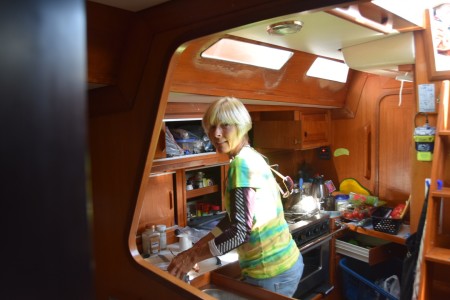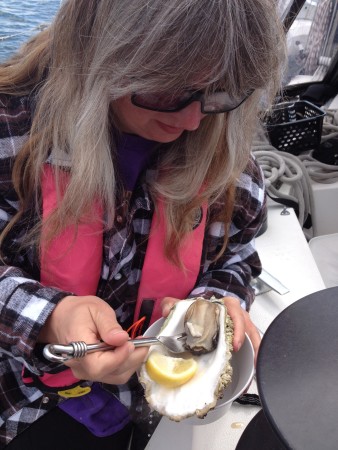Thing to Consider
Our 2-week circumnavigation of Vancouver Island on Tim Melville’s Baltic 42 may have been a tad disappointing due to a total lack of wind. but we did learn a ton of stuff that should help us in our own adventure. Some of it is pretty obvious and some is just knowledge we already had but needed to actually experience.
Stowage
6 people on a boat for 2 weeks with no shore leave and no real stops changes how you approach galleys and storage. We tend to maintain an impeccable galley with everything stowed out of sight and away. But Donna didn’t have that privilege with so many supplies. Instead laundry baskets and containers were often left out but wedged in tightly to prevent movement. Every nook and cranny in Baltic had something in it and was arranged for maximum efficiency. This is definitely something we are going to have to work at.
Preventers
I’ve read a lot about preventers, but never had the opportunity to rig one. It was actually pretty simple. A preventer is simply a method of preventing the boom from swinging (crashing really) back towards the boat when it has been let out. Many of the systems I had read about were complex and involved running lines forward through blocks and back to the cockpit. But on the Northern Passage it was a simple as tying off a line from the end of the boom to the toerail. The downside with this simplified system is you had to go out on deck to tack or drop the sails. But given the light winds (when there was wind) it wasn’t an issue.
Spinnakers
We got the spinnaker up on one of the days. It was a full symmetrical and a real beauty. But it was a pain to get up, a pain to sail with and a pain to get down. I can see how an asymmetrical or even a gennaker would be a much better investment.
The issue is that with a loose foot, you need to pole it out and the pole, baby stay and forestay all had to play nice. Then it became extremely important to maintain a course relative to the wind so it wouldn’t collapse; which meant that your actual heading was less important than where the wind shifted to.. On top of that, it’s a huge sail and managing it with less than the 4 we had would have taken a lot of practice and technique. But it was fun while it lasted.
Wing on wing
So instead of the spinnaker, we generally ran wing-on-wing downwind. So much easier when you have a preventer rigged and the winds are holding steady. Those two little things made the whole exercise a whole lot more comfortable than the awkward attempts we have previously made.
Close hauled vs beam reach
They say a broad reach (running 90° to the wind) is the fastest point of sail. But close hauled (running about 30° to the wind—as close as you can get) always seems a lot faster. That’s because you are generally heeled over and the waves are screaming by 6 inches from your ass. What they also say and I never quite internalized is that not only is beam reach (or better yet a broad reach) faster, it is also way more comfortable. It really is. We would be sailing along on a broad reach with a following sea and it felt like we were standing still. But we were actually zooming along at over 6 knots.
But that also makes it more dangerous as you can be way over-canvassed without necessarily realizing it, as the effects of the wind are much less noticeable.
Crab traps
I’ve always disliked crab traps. The ones cluttering up the ocean, not the idea of crab traps themselves, but now I have a positive hate on for them. During the trip we had tons of close calls, especially at night but it was when I ran over one that had a tiny, dirt-encrusted float and wrapped it around the rudder that I got mad. This was a commercial trap—which are huge—and the weight of it brought our boat to a standstill. Luckily it was only around the rudder and we were able to cut it free. But with a bit more bad luck it could have wrapped itself around the propellor shaft and that might of meant having to dive to cut it free.
I am now a huge fan of introducing some legislation making them use big orange floats. Stupid crab traps.
Steamed oysters
And finally steamed oysters. I have learned to really enjoy raw oysters since our first foray two years ago, but every time I have tried them cooked it has left a bad taste in my mouth — literally. But when Tim et al. collected a bunch in the Broken Group we popped them on the BBQ and steam cooked them. A bit of garlic butter and they were scumpdillyicious!
~~~
Hopefully there tons more things for us to learn. But for now, we are just a few days from casting off and the waiting is killing us.






Pingback: Preventers | The Chronicles of Laughing Baby